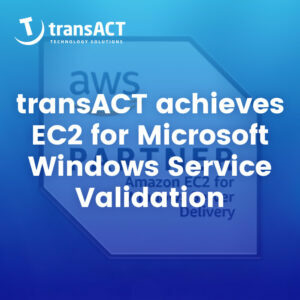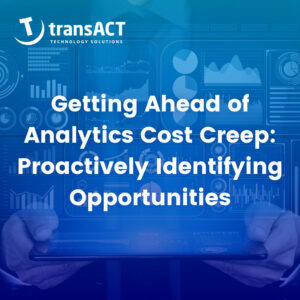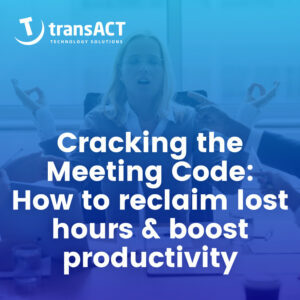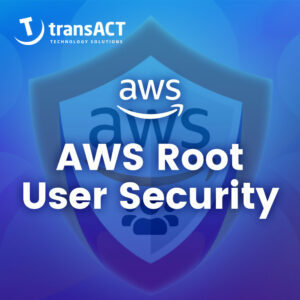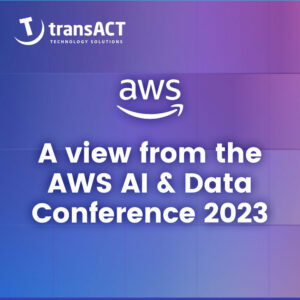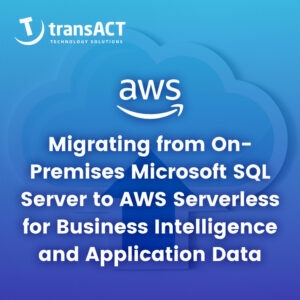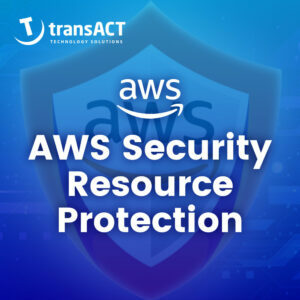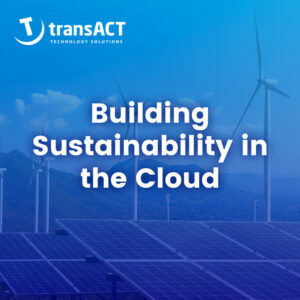5 New Year’s Resolutions to Further Your Cloud Transformation.
January 25, 2022 - transact.marketing
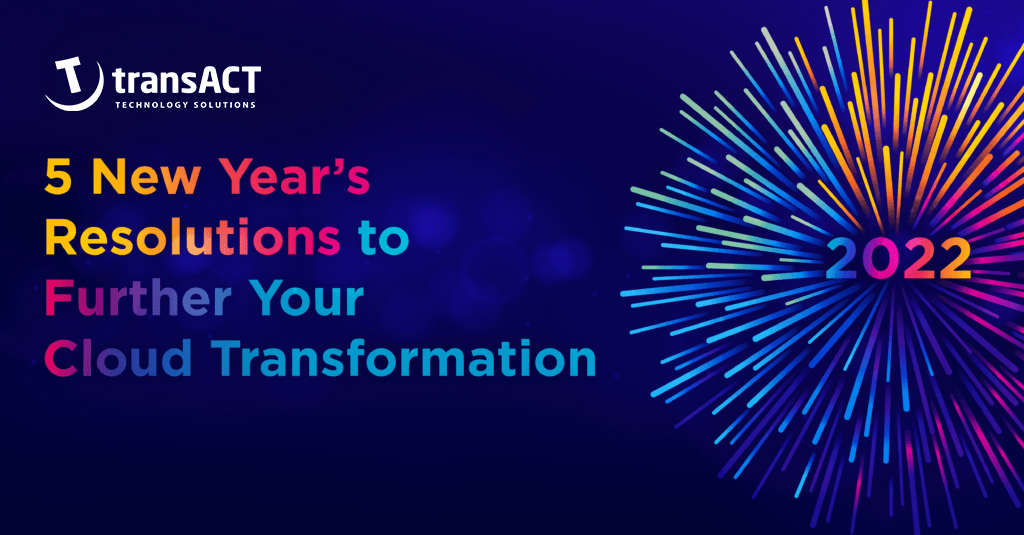
Has the uncertainty from 2020 and 2021 pushed aside your plans for cloud transformation? If so, you’re not alone. According to CloudCheckr's 2021 Cloud Infrastructure Report, 93% of respondents faced budget challenges going into this year, and 55% had no baseline for planning after the pivots they made in 2020.
However, many organizations aren’t letting those obstacles stand in their way. It is estimated that in 2022 the Cloud Computing market is expected to exceed $482 billion worldwide, according to Gartner. Gartner also named several key trends in cloud computing, with the top being cloud ubiquity or the increased need for organizations to adopt the cloud and related services. Therefore, cloud computing will only become more in-demand for organizations in the coming years.
In other words, you can’t avoid cloud transformation forever. With the start of a new year, you have the opportunity to plan ahead for the year and beyond with a fresh cloud-first strategy. Either way, your timing is great.
Right now, you have the opportunity to set these five cloud transformation resolutions for the new year.
Resolution 1: Maximize this year’s budget for a clean slate in 2022
If you have a “use-it-or-lose-it” fiscal year budget, then you already know you need to spend money now or risk seeing decreased future funding. If you’re facing a surplus at the moment, there are ways to take advantage of your end-of-the-year funds. One way is to prepay for next year’s cloud capacity with commitment discounts.
In AWS, for example, these discounts include paying for Reserved Instances and Savings Plans. For these, you can choose either one or three-year terms. Prepaying for cloud computing can help you make smart decisions for next year’s budget and take advantage of lower costs right now. In general, Reserved Instances can provide a discount of up to 72% when compared with on-demand EC2 instance pricing.
Resolution 2: Kick-off new projects with a cloud-first strategy
Going “cloud-first” means that you always have the exact computing capacity you need on any given day. This strategy helps businesses reduce wasteful spending and intelligently plan for expansion with their existing cloud resources.
Operating in the cloud differs from running a data centre as you have to option to use on-demand and pay as you go pricing models. These models allow you to have the exact capacity you need when you need it. For example, you are planning for a spike in traffic during the Black Friday and Cyber Monday sales, you are able to scale instantly to meet the demand and scale back down once the spike settles, meaning you don’t have to have your resources commissioned at full capacity. Compare this to running a data centre, you need to have the servers on hand to handle the spiked capacity at all times, even though you might not use the full computing power day to day.
To kick off a cloud-first strategy, you must consider the 6 R’s of migrating to the cloud. These strategies outline which process you need to complete in order to see the most success in your cloud investment.
1. Rehosting — Otherwise known as “lift-and-shift.”
You may find that many early cloud projects gravitate toward new development using cloud-native capabilities, but in a large legacy migration scenario, where the organization is looking to scale its migration quickly to meet a business case, you find that the majority of applications are rehosted.
GE Oil & Gas, for instance, found that even without implementing any cloud optimizations, it could save roughly 30%of its costs by rehosting.
Most rehosting can be automated with tools (AWS CloudEndure Migration, AWS VM Import/Export), although some customers prefer to do this manually as they learn how to apply their legacy systems to the new cloud platform.
Many find that applications are easier to optimize/re-architect once they’re already running in the cloud. Partly because your organization will have developed better skills to do so, and partly because the hard part — migrating the application, data, and traffic — has already been done.
2. Replatforming — I sometimes call this “lift-tinker-and-shift.”
Here you might make a few cloud optimizations in order to achieve some further benefits, but you aren’t changing the core architecture of the application. You may be looking to reduce the amount of time you spend managing database instances by migrating to a database-as-a-service platform like Amazon Relational Database Service (Amazon RDS) or migrating your application to a fully managed platform like Amazon Elastic Beanstalk.
3. Repurchasing — Moving to a different product.
Most commonly repurchasing is seen as a move to a SaaS platform (Software as a Service). Moving a CRM to Salesforce.com, an HR system to Workday, a CMS to Drupal, and so on.
4. Refactoring / Re-architecting
Re-imagining how the application is architected and developed, typically using cloud-native features. This is typically driven by a strong business need to add features, scale, or performance that would otherwise be difficult to achieve in the application’s existing environment.
Are you looking to migrate from a monolithic architecture to a service-oriented (or server-less) architecture to boost agility or improve business continuity? This pattern tends to be the most expensive, but, if you have a good product-market fit, it can also be the most beneficial.
5. Retire — Get rid of.
Once you’ve discovered everything in your environment, you might ask each functional area who owns each application. It's found that as much as 10% (up to 20%) of enterprise IT portfolios are no longer useful, and can simply be turned off. These savings can boost the business case, direct your team’s scarce attention to the things that people use, and lessen the surface area you have to secure.
6. Retain — Usually “revisit” or do nothing (for now).
Maybe you’re still riding out some depreciation, aren’t ready to prioritize an application that was recently upgraded, or are otherwise not inclined to migrate some applications. You should only migrate what makes sense for the business; and, as the gravity of your portfolio changes from on-premises to the cloud, you’ll probably have fewer reasons to retain.
You may need to do some or all of these steps, depending on which applications, services, and workloads you want to replicate or establish in the cloud.
Resolution 3: Source new talent and train current employees
Let’s talk about the elephant in the room: “The Great Resignation.” One of the ways to avoid seeing qualified employees walk out the door is to ensure that they have the resources they need to do their jobs well.
What if you train people and they leave? This is a common fear for employers as they weigh the costs and benefits of continued employee education. But there’s a better question to ask in this situation, with far more dire consequences: What if you don’t train them, and they stay?
Training employees makes them more empowered and efficient. Yes, someday they might go somewhere else, and you’ll have to compete to keep them on your team. But when you give your staff advancement opportunities and training, they can feel that they make a valuable contribution to the organization. That effort can go a long way in retaining your best workers.
Conversely, if you try to save money by not investing in training, all you end up with is an untrained staff. In fact, not training your employees could cost you more. In a report from Skillsoft, two-thirds of employers surveyed estimate that lack of on-the-job skills results in between three and nine hours per week of lost productivity for an IT professional. An additional 12% of decision-makers say that untrained employees lose as much as 10 hours of productivity per week. That adds up to 520 hours per year, and a cost, on average of about $29,000, according to Skillsoft. In short, it’s costing you more to not train your employees.
And what about attracting new employees? By offering on-the-job training and opportunities for advancement, you can improve recruitment efforts and better retain these new additions to your team.
Resolution 4: Implement new tech like serverless and containers
You never want to adopt new technology just for new technology’s sake. But there are many innovations on the market that can help you save time and money whilst meeting other objectives that you set for 2022.
Serverless
Serverless architecture enables you to build and run servers without having to manage their infrastructure. An additional benefit of serverless is that once the project concludes and you no longer need to run these resources, you don’t have to keep paying for them.
Containers/Kubernetes
Containers allow you to compartmentalize your applications and run them easily on public cloud or on-premises. You might also choose to use Kubernetes, also known as K8s, which is an open-source system that automates deployment, scaling, and management of containerized applications.
Multi-Factor Authentication
By requiring both a password and an additional code sent via text, email, or to a keyfob, organizations can promote better cybersecurity practices. This means that even if passwords are compromised, there is an additional line of defence between hackers and your IT resources.
Virtual Desktops
With the recent release of Windows 11, IT administrators would have their work cut out for them if they had to update all operating systems within an enterprise. The quickest way to enable employees to take advantage of new features is to enable them through a Virtual Desktop. In this case, the IT personnel can update the OS on a server and give everyone remote access to that new OS through Virtual Desktop.
Resolution 5: Leverage the resources you already have at your disposal
Finally, remember not to discredit the resources you already have on your side. One way to do so is to look to your vendors for help.
Managed service providers (MSPs) are there to help you succeed in the cloud. For example, if you’re looking into the differences between Amazon Workspaces (Platform-as-a-Service) and Amazon AppStream 2.0 (SaaS), your MSP can help you decide which will work for your business needs — and your budget. Using technology, like a cloud management platform? This gives you the advantage of increased visibility as you plan cost management, security, and cloud resource initiatives for the new year.
As we tackle the new year, reach out to our cloud team to get their expertise and guidance, they’ll be glad to help.
If you want to find out more about how you can reach your 2022 cloud goals contact: cloud@transactts.com
